The aerodynamic truck of the future
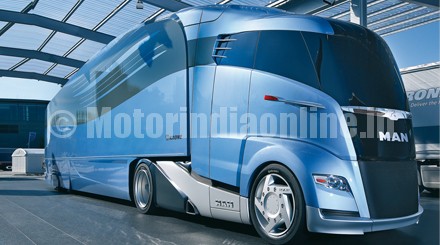
The MAN Concept S truck study shows what can be achieved by combining an aerodynamic design with additional innovations: up to 25% less fuel consumption and a sustainable reduction in CO2 emissions. The vehicle concept is a perfect blend of the streamlined MAN Concept S tractor unit and the matching Krone AeroLiner trailer, forming a single aerodynamic unit with the same amount of loading space as today’s semi-trailer tractors.
Krone and MAN’s joint study is a real head turner. If the Concept S reminds you of a dolphin, then you’re right on track. The design of the semi-trailer tractor features efficient lines – just like the body of a dolphin – enabling extremely low aerodynamic drag similar to that for cars.
A rounded front, streamlined integrated tanks, and an intelligent roof spoiler concept, the optimized design facilitates outstanding air-flow around the entire semi-trailer tractor.
The Concept S’s fascinating design gives a glimpse into the future in terms of safety, environmental protection and efficiency. The vehicle has the load volume of a conventional truck while at the same time achieving the extremely low drag coefficient of a passenger car. This enables savings in fuel consumption and thus CO2 of up to 25 per cent.

Against a background of globally increasing demand for energy, continually rising transport volumes and the finite nature of fossil resources, logistics companies, vehicle manufacturers, consumers and politicians are all called on to play their part in reducing CO2 emissions, particularly in the transport sector. Fleet consumptions of passenger cars and light commercial vehicles are already stipulated by law: now, the political discussion is focusing increasingly on heavy commercial vehicles. There are indications that a law regulating CO2 for heavy trucks over 12 tonnes will also be passed in Europe in the near future.
One possible answer to the question of how fuel consumption and the resulting CO2 emission can be reduced significantly and sustainably in long-haul transport is given by MAN together with trailer manufacturer Krone with their presentation of the aerodynamically optimised road train at IAA 2012.
“The area in which considerable savings in CO2 in the operation of heavy commercial vehicles are realised can be found in the consideration of truck and trailer together and here primarily in the aerodynamic design of the vehicle as a whole. That’s where the biggest potential is,” says Anders Nielsen, CEO of MAN Truck & Bus.
Until now, the external form of the truck has meant that these vehicles have had to cope with a great amount of air resistance: depending on the route profile, overcoming this resistance requires up to 37 per cent of the total energy used by the truck. That costs fuel and results in corresponding CO2 emissions. The rectangular block form of today’s trucks is accounted for by the need for maximum utilisation of the space available within the statutory limitation imposed on the length of road trains at 16.5 metres.
The innovative truck-trailer combination makes it possible to tap into considerable aerodynamic potentials. To this end, however, tractor and trailer have to be somewhat longer, towards both front and rear. This is in order to realise the more streamlined front end of the vehicle with its rounded radiator as well as the aerodynamic rear end while keeping the loading capacity the same.
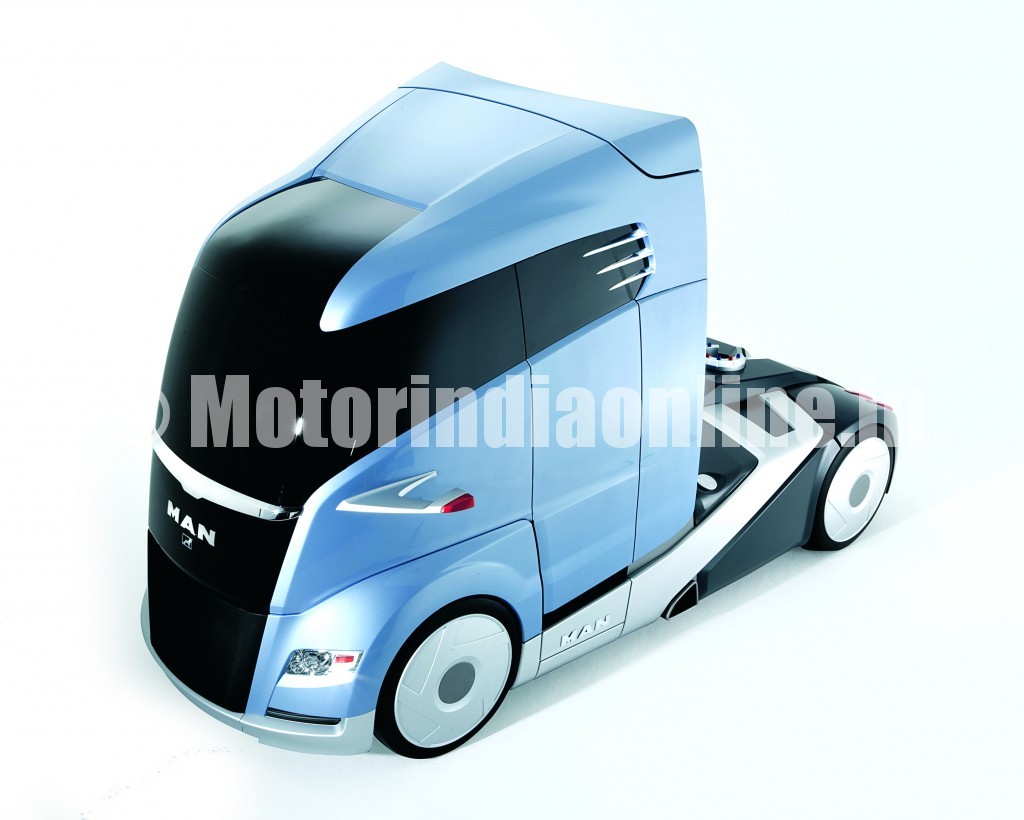
Manufacturers of commercial vehicles are capable of putting an aerodynamically optimised vehicle such as the concept presented here on the road as early as the next vehicle generation. But this can become a reality only when the statutory regulations restricting the length of road trains have been amended. “Politicians could achieve big gains in environmental protection with a minor change to the law while simultaneously utilising the innovative strength of Europe’s commercial vehicles industry. 2.30 metres more length would suffice,” says Anders Nielsen. The EU Commission has already announced a lengthening of the driver’s cab as well as the rear end of the vehicle in its proposed Directive.
By comparison with a conventional 40-tonne train, the MAN Concept S with trailer and optimised auxiliary units reduce fuel consumption and thus CO2 emissions per tonne-kilometre by up to a quarter. The development of the aerodynamics took account of the airflow around the train as a whole, starting with the tractor’s rounded front section, the reduced area of its mirrors and the streamlined, integrated tanks. In a newly developed concept, the spoiler is integrated in a form-fitting manner into the roof of the driver’s cab. It closes the gap between the tractor and trailer completely, allowing an even airflow over the vehicle without separation. The trailer’s full-size side finishers and tapered rear complete the optimal flow of air around the road train. This has additional synergetic effects: the side finishers enhance safety and also make a contribution to lightening the load on the environment by reducing noise.
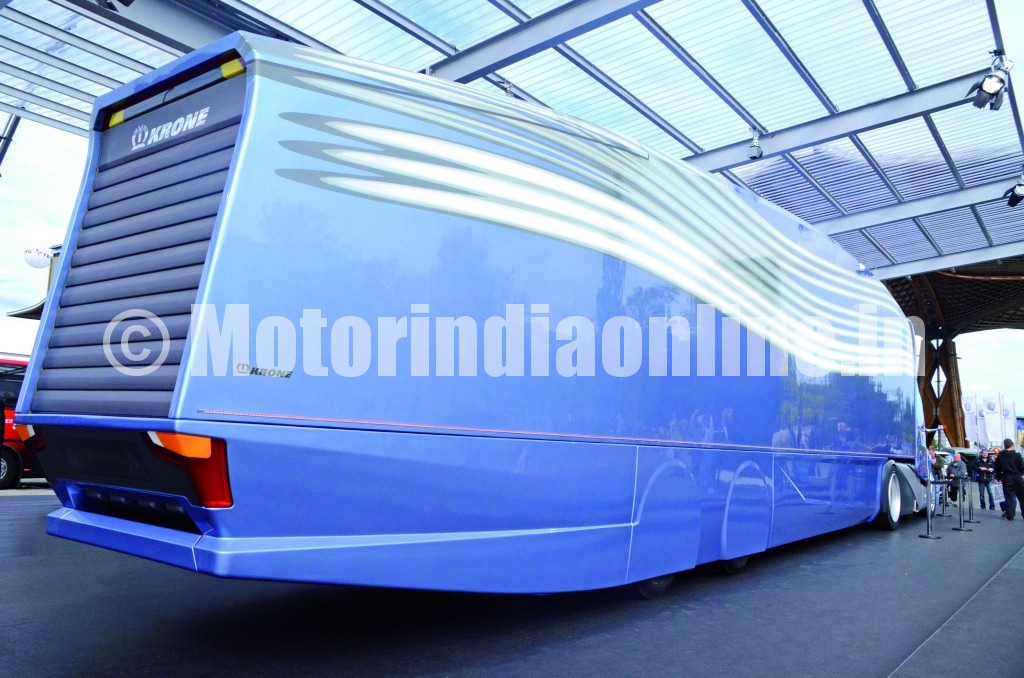
With its streamlined front, its projecting wheel arches and the soft, smooth lines of its cab, the MAN Concept S is a radical departure from the cubic design of the conventional trucks we see on our motorways today. The design was rigorously adjusted in the wind tunnel until its extremely low air resistance was attained. With its drag coefficient (cD value) of around 0.3, the concept road train enters a domain of aerodynamic quality previously inhabited only by modern passenger limousines.
“Our Concept S, in conjunction with an aerodynamically optimised semi-trailer, is as streamlined as a modern passenger car. We proved it in the wind tunnel. The savings in consumption are absolutely realistic,” states HolgerKoos, head truck designer of MAN Truck & Bus.
In the Concept S, the supporting frame and the two fuel tanks are integrated into the external bodywork design, where they help to guide the flow of air past the truck. One would search in vain for conventional rear-view mirrors on the MAN Concept S – their function has been taken over by cameras built into the wing-like mounts for the indicator units left and right. Despite its ta-pered rear end, the road train’s loading volume is the same as that of a conventional truck.
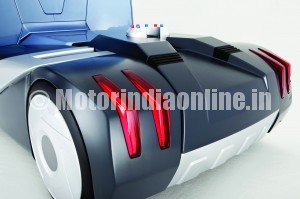
A practical development
The development of the Concept S and the AeroLiner focused throughout on the demands of the haulage and logistics sector, where price is critical. Besides this aspect, loading and unloading operations are also straightforward and safe. “The semi-trailer functions exactly like any other conventional trailer. Despite the streamlined tapering of the vehicle towards the rear, the trailer is suitable for every ramp,” explains Krone’s head of Sales and Marketing, Dr. Frank Albers. The trailer design meets all the requirements for loading and unloading at ramps and is equipped with a tailgate that can be raised.
In addition to its aerodynamically optimised design, the vehicle is also a standard-bearer for cutting-edge technology. The extended cab offers more space for the installation of electronic safety and driver-assistance systems. The lengthening of the cab also makes it possible to integrate high-performance crumple zones that absorb energy in the event of a collision and can thus contribute significantly to reducing the consequences of an accident.
The full-size finishers would be optimal side and rear underride guards, so that a train like this would provide greater road safety. Thanks to the rounded front end, the driver has a better view of the area in front and to the side of the cab. A reversing camera mounted on the trailer optimises vision when manoeuvring. Particularly innovative is the rear display integrated in the trailer. Using LEDs visible from a long distance, this provides the vehicles behind with information on traffic jams or danger on the road ahead.
For greater safety in operation and protection against overloading, an on-board system monitors the axle loads and tyre pressures of truck and trailer. Further safety components are dynamic nose-weight reduction and anti-roll control on the trailer.
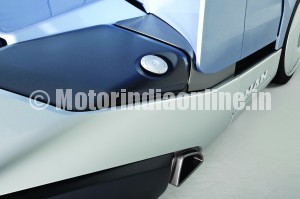
A sustainable transport solution
What is important today is to set the course so that a considerable reduction in CO2 emission is achievable, from both the technical and commercial points of view. Fundamental to MAN and Krone’s joint development of the first integrated complete vehicle was that tapping the potentials offered by aerodynamics at this magnitude is possible at realistic costs to customers, manufactures and consumers. The concept could be realised by vehicle and trailer manufacturers as early as the next truck generation. It has none of the technical and commercial uncertainties that the fully electrical operation of heavy commercial vehicles has, from the perspective of current technological assessments.
In order to fulfil the customer’s desire for maximum transport capacity, legislators must change the applicable regulations on dimensions and weights in Directive 96/53/EU so that the potential with regard to the reduction of drag in road trains can be utilised. This would enable improvements in the efficiency of goods transport by road that have so far remained unused, with significant savings in fuel consumption. CO2 savings at this level can only be achieved by an integrated complete vehicle that is aerodynamically optimised while still providing the same loading volume as today’s road trains.